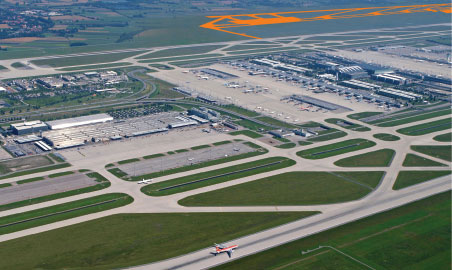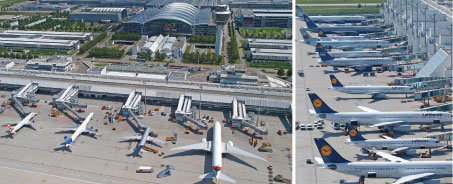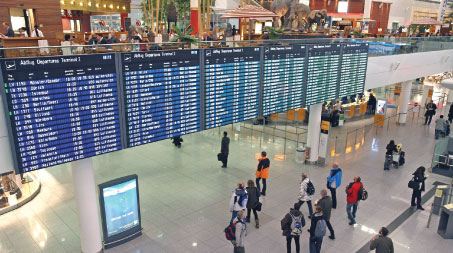
Approval for a third runway is a substantial element of the airport’s investment plan. The public consultation is now complete with the government’s final decision expected next year. Credit: Flughafen München GmbH
As airports continue to feel the effects of weakened demand for air travel – a by-product of the world’s shrinking economies, Munich airport expects its own performance to stabilise sooner rather than later, Dr Michael Kerkloh, CEO, explained. “We have reached the bottom line of the economic crisis and expect our 2009 results to be significantly better than our first half results. But we will still see an overall drop in traffic.”
In the first half of 2009, Munich airport – jointly owned by the Free State of Bavaria (51% shareholding), the Federal Republic of Germany (26%) and the City of Munich (23%) – saw a 9.4% year-on-year drop in passenger numbers and handled 18% less freight traffic.

The Munich Airport Centre (MAC) opened in 1999 and connects Terminal 1 and 2. Credit: Flughafen München GmbH
While current market conditions make it difficult to predict an airport’s recovery, Munich airport is pressing on with a €2 billion investment package to help prepare for the long-term growth it is forecasting. “We expect moderate growth in 2010 and hope to return to traditional, dynamic growth by 2011. We don’t think there is a reason to review our long-term prognosis as we still expect to reach more than 50 million throughput in 2020,” said Kerkloh.
Capacity increases will be met through the first phase of the investment. While the airport’s schedule of operations is split between Terminals 1 and 2, a new satellite on Terminal 2’s eastern apron will be the only expansion necessary in the longer term, explained Kerkloh. “We want to extend the building that is already used on the apron, which is at the moment used for baggage handling. The first phase will be making this ready for passengers to use by adding a second storey.”

Terminal 2 is dedicated to Lufthansa and the Star Alliance through a joint venture with Munich airport. Kerkloh: “This public-private partnership ensures we have the most efficient and attractive hub terminal for international traffic.” Credit: Flughafen München GmbH
Terminal 2 is dedicated to Lufthansa and the Star Alliance through a joint venture with Munich airport (Lufthansa holds 40% and the airport 60% of the shares). “This public-private partnership ensures we have the most efficient and attractive hub terminal for international traffic,” he said. The terminal spans 260,000sqm of floor space, with 124 check-in counters and 24 air bridges shared between 114 gates.
Architects Koch + Partner, who were responsible for Terminal 2, are now drawing up plans for the new satellite, which will be linked with an underground transfer system to Terminal 2. When ready, capacity will be available for 11 million additional passengers, as well as provision for up to 27 aircraft stands.
Last year, Terminal 2 handled 25 million passengers, while throughput levels in Terminal 1 – which serves mainly point-to-point traffic – reached 10 million.
Terminal 1 will not be expanded, despite its modular structure. “We have space to deal with the growth we expect here, but the structure does give us the possibility to use the terminal for different kinds of traffic,” said Kerkloh.
Third runway
Approval for a third runway is a substantial element of the airport’s investment plan. A public consultation is now complete with the government’s final decision expected next year. “The need for the runway is there and if this goes ahead, we will be able to take the number of planned aircraft movements from our current allowance of 90 per hour to 120 per hour. It would enable us to continue our dynamic development of a growing hub in Europe,” said Kerkloh.
Since starting operations in May 1992, Munich has grown its status from 15th highest in Europe for passenger numbers, to 7th for passenger traffic today – a trend it intends to continue. Munich is ranked 6th in terms of passenger movements. “We want to keep enforcing our strength as a European hub by extending our capacity and ensuring we can compete successfully with other European hubs. We definitely need expansion and the third runway to do that,” said Kerkloh.

Credit: Flughafen München GmbH
A sustainability report will be published in the autumn. “Environmental sustainability is a key issue for us. We plan to meet our growth targets in 2020 while ensuring CO2 neutral growth,” explained Kerkloh.
Cargo
Over the last few years Munich’s cargo traffic and belly freight have grown faster than passenger traffic – largely due to Munich’s position as a European hub. As exports slow, Munich is seeing a higher ratio of traffic across intercontinental than domestic or European flights, explained Kerkloh. “The stronger the growth in passenger traffic, the more progress we will make with cargo operations. We have a stable base of European feeder traffic and the aim for the coming years is to step-by-step increase our intercontinental traffic.”







